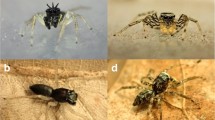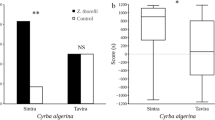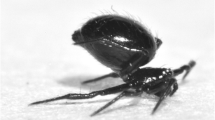Abstract
Laboratory studies of animal behavior can use animals with different developmental histories, including those that have spent most of their lives in the field or those raised in the laboratory. Both types of animals are assumed to respond similarly to experimental treatments. The goal of this study was to test if this assumption is true, if field-collected and lab-reared animals respond similarly to experimental treatments. In the first experiments, we test how diet (high lipid or protein) affected mating behaviors of male jumping spiders, Phidippus audax. Male spiders had opposite responses to diet based on their rearing condition in both scramble competition and male-male interaction trials. Field-collected spiders fed with high-protein diets and lab-reared spiders fed with high-lipid diets found mates quicker and were more aggressive than their counter parts fed with different diets. Field-collected spiders were also more active in open arenas and courted females more actively than lab-reared spiders. In a second experiment, we tested spiders for preference of flower color, and found that both lab-reared and field-collected spiders selected flowers with color over white flowers. However, field-collected spiders prefer red flowers with UV fluorescence, while lab-reared spiders seem to prefer red without UV. These results suggest that lab-reared and field-collected animals can respond differently to the same experimental treatments. Further work is needed to test if this happens in other animals, and which types of individuals (lab-reared or field collect) best reflect the responses of animals in nature.
Significance statement
Laboratory studies are commonly used to study animal behavior. Animals used in these studies can be either raised in the laboratory or collected from the field just prior to the study. While lab-reared and field-collected animals can differ sometimes in their behavior (e.g., more or less active in response to a treatment), they are both assumed to respond in qualitatively the same manner. However, this does not appear to be the case in our study of a common species of jumping spider, Phidippus audax. Lab-reared and field-collected animals responded in opposite directions to identical treatment conditions. These results suggest that the developmental histories of animals can fundamentally affect how they respond to experimental treatments in the laboratory and, hence, the conclusions drawn from such studies.



Similar content being viewed by others
References
Bierbach D, Schulte M, Herrmann N, Tobler M, Stadler S, Jung CT, Indy JR (2011) Predator-induced changes of female mating preferences: innate and experiential effects. BMC Evol Biol 11:190
Burns JG, Saravanan A, Helen RF (2009) Rearing environment affects the brain size of guppies: lab-reared guppies have smaller brains than wild-caught guppies. Ethology 115:122–133
Calisi RM, Bentley GE (2009) Lab and field experiments: are they the same animal? Horm Behav 56:1–10
Campbell DL, Weiner SA, Starks PT, Hauber ME (2009) Context and control: behavioral ecology experiments in the laboratory. In Annales Zoologici Fennici 46:112–123
Carducci JP, Jakob EM (2000) Rearing environment affects behavior of jumping spiders. Anim Behav 59:39–46
Chalcoff VR, Aizen MA, Galetto L (2005) Nectar concentration and composition of 26 species from the temperate forest of South America. Ann Bot 97:413–421
De Voe RD (1975) Ultraviolet and green receptors in principal eyes of jumping spiders. J Gen Phys 66:193–207
Fenster CB, Armbruster WS, Wilson P, Dudash MR, Thomson JD (2004) Pollination syndromes and floral specialization. Annu Rev Ecol Evol Syst 35:375–403
Galef BG (2004) Approaches to the study of traditional behaviors of free-living animals. Anim Learn Behav 32:53–61
Hebets EA (2003) Subadult experience influences adult mate choice in an arthropod: exposed female wolf spiders prefer males of a familiar phenotype. Proc Natl Acad Sci 100:13390–13395
Jackson RR, Cooper KJ (1991) The influence of body size and prior residency on the outcome of male-male interactions of Marpissa marina, a New Zealand jumping spider (Araneae: Salticidae). Ethol Ecol Evol 3:79–82
JMP®, Version 12. SAS Institute Inc., Cary, NC, 2016
Kasumovic MM, Andrade MC (2004) Discrimination of airborne pheromones by mate-searching male western black widow spiders (Latrodectus hesperus): species-and population-specific responses. Can J Zool 82:1027–1034
Kasumovic MM, Hall MD, Brooks RC (2012) The juvenile social environment introduces variation in the choice and expression of sexually selected traits. Ecol Evol 2:1036–1047
Kasumovic MM, Hall MD, Try H, Brooks RC (2011) The importance of listening: juvenile allocation shifts in response to acoustic cues of the social environment. J Evolutionary Bio 24:1325–1334
Kihslinger RL, Nevitt GA (2006) Early rearing environment impacts cerebellar growth in juvenile salmon. J Exp Bio 209:504–509
Kleinteich A, Wilder SM, Schneider JM (2015) Contributions of juvenile and adult diet to the lifetime reproductive success and lifespan of a spider. Oikos 124:130–138
Langford GJ, Macedonia JM, Bessette CW, Matey JL, Raboin BA, Schiffmacher AE, Reynolds BJ (2014) Phenotypic plasticity in the relative hind-limb growth of lab-reared Anolis sagrei: replication of experimental results and a test of perch diameter preference. JHerp 48:228–232
Liedtke J, Schneider JM (2014) Association and reversal learning abilities in a jumping spider. Behav Process 103:192–198
McCall C, Primack RB (1992) Influence of flower characteristics, weather, time of day, and season on insect visitation rates in three plant communities. Am J Bot:434–442
Miller TE, Legaspi JC, Legaspi B (2010) Experimental test of biotic resistance to an invasive herbivore provided by potential plant mutualists. Biol Invasions 12:3563–3577
Noldus LPJJ, Spink AJ, Tegelenbosch RAJ (2001) EthoVision: a versatile video tracking system for automation of behavioral experiments. Behav Res Methods Instrum Comput 33:398–414
Olsson J, Quevedo M, Colson C, Svanbäck R (2007) Gut length plasticity in perch: into the bowels of resource polymorphisms. Biol J Linn Soc 90:517–523
Pritchard DJ, Hurly TA, Tello-Ramos MC, Healy SD (2016) Why study cognition in the wild (and how to test it)? J Exp Anal Behav 105:41–55
Raubenheimer D, Rothman JM (2013) Nutritional ecology of entomophagy in humans and other primates. Annu Rev Entomol 58:141–160
Relyea RA, Werner EE (1999) Quantifying the relation between predator-induced behavior and growth performance in larval anurans. Ecology 80:2117–2124
Schrijver NC, Bahr NI, Weiss IC, Würbel H (2002) Dissociable effects of isolation rearing and environmental enrichment on exploration, spatial learning and HPA activity in adult rats. Pharmacol Biochem Behav 73:209–224
Shahbazi M, Jimenez P, Martinez LA, Carruth LL (2014) Effects of housing condition and early corticosterone treatment on learned features of song in adult male zebra finches. Horm Behav 65:226–237
Shillington C, Verrell P (1997) Sexual strategies of a North American ‘tarantula’(Araneae: Theraphosidae). Ethology 103:588–598
Silberglied RE (1979) Communication in the ultraviolet. Annu Rev Ecol Syst 10:373–398
Soma M, Takahasi M, Ikebuchi M, Yamada H, Suzuki M, Hasegawa T, Okanoya K (2006) Early rearing conditions affect the development of body size and song in Bengalese finches. Ethology 112:1071–1078
Wagner CE, McIntyre PB, Buels KS, Gilbert DM, Michel E (2009) Diet predicts intestine length in Lake Tanganyika’s cichlid fishes. Funct Ecol 23:1122–1131
Wolff D (2006) Nectar sugar composition and volumes of 47 species of Gentianales from a southern Ecuadorian montane forest. Ann Bot 97:767–777
Wilder SM, Yuan L, Roumilhac C, LeGal A, Raubenheimer D, Simpson SJ, McAllan BM (2016) Three-dimensional diet regulation and the consequences of choice for weight and activity level of a marsupial carnivore. J Mamm 97:1645–1651
Zuk M, Garcia-Gonzalez F, Herberstein ME, Simmons LW (2014) Model systems, taxonomic bias, and sexual selection: beyond drosophila. Annu Rev Entomol 59:321–338. https://doi.org/10.1146/annurev-ento-011613-162014
Acknowledgements
We thank Oklahoma Gas & Electric for allowing WDW access to Sooner Lake Dam. We would also like to thank all the undergraduates that helped with spider and lab maintenance.
Funding
Funding was provided by Oklahoma State University.
Author information
Authors and Affiliations
Corresponding author
Additional information
Communicated by J. Pruitt
Rights and permissions
About this article
Cite this article
Wiggins, W.D., Bounds, S. & Wilder, S.M. Laboratory-reared and field-collected predators respond differently to same experimental treatments. Behav Ecol Sociobiol 72, 19 (2018). https://doi.org/10.1007/s00265-017-2437-7
Received:
Revised:
Accepted:
Published:
DOI: https://doi.org/10.1007/s00265-017-2437-7




